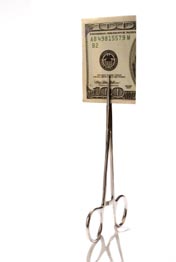Can bonuses of $10,000 or more spur primary care doctors to cut expensive hospital admissions and emergency room visits without harming care?
 CareFirst BlueCross BlueShield says the answer is yes. The insurer, which covers people in Maryland, Washington and Virginia, says its “patient-centered medical program” shaved $40 million — or 1.5 percent — off expected costs last year, its first in operation. Much of the savings came from reducing unnecessary hospital visits by patients with diabetes and other chronic illnesses, the company said.
CareFirst BlueCross BlueShield says the answer is yes. The insurer, which covers people in Maryland, Washington and Virginia, says its “patient-centered medical program” shaved $40 million — or 1.5 percent — off expected costs last year, its first in operation. Much of the savings came from reducing unnecessary hospital visits by patients with diabetes and other chronic illnesses, the company said.
While 1.5 percent “sounds like a small number,” CareFirst expects greater savings for 2012 and later as doctors adjust to the program, company CEO Chet Burrell told reporters on Thursday. “It would not be unreasonable to expect a bending of the cost curve of 3 to 5 percent within a given year. … If we get a cumulative effect from this over time, from society’s standpoint it does start to control the rise of health care costs.”
CareFirst’s is one of numerous experiments in which primary care doctors are being offered pay increases for hitting quality and efficiency targets. It is notable, however, for its size and breadth. The 3,600 doctors and nurse practitioners who signed up for the program represent 80 percent of the eligible caregivers in CareFirst’s territory, the company said. They care for nearly 1 million CareFirst members.
CareFirst’s costs for those patients still went up last year — just not as much as the 7.5 percent the insurer had projected. This kind of measure isn’t the most rigorous gauge of a program’s success, said Paul Ginsburg, president of the Center for Studying Health System Change.
“We have no way of knowing what their costs would have been if they hadn’t done this,” he said.
Still, Ginsburg said he was encouraged by CareFirst’s attempt to control medical use and especially by the raises given to family practitioners, pediatricians and other primary care doctors, who many believe are underpaid.
“Given the very widespread concern that we’re losing our primary care supply because primary care has become so much less lucrative than some specialties, there’s an urgency on the part of policymakers and also private insurers to somehow get more money out there to help the primary care physicians,” he said.
Doctors who signed up for the program automatically got a 12 percent pay increase. The ones who met efficiency and quality goals will get additional bonuses of about 20 percent — $12,000 or so on average — starting July 1, Burrell said. (CareFirst patients represent only a portion of the income and practice for most participating doctors.)
The $40 million in savings last year doesn’t include the bonuses, which will come to about $22 million, he said. While the insurer is still analyzing the savings, Burrell said they generally came from cutting unnecessary hospital use by patients with diabetes, heart conditions and other chronic illnesses.
“The cycle of breakdown, admission, readmission and ER visit was lessened,” he said. “A year doesn’t make a definite pattern. What seems to have started to occur is that these patients were better stabilized.”






